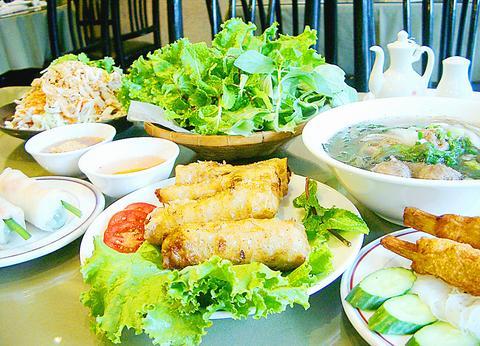Madame Jill's was the first Vietnamese restaurant to come to Taipei, when the Vietnam War was still raging. In 1974, the Lin family (overseas Chinese) moved to Taipei because of the war and set up the first branch of Madame Jill's, across the street from National Taiwan University. Over the past 30 years three other branches have been established and they remain frequently visited spots around the neighborhood.
With southeast Asian food becoming more popular in recent years and with more Vietnamese wives opening their own restaurants in the country, Madame Jill's nevertheless thrives, surviving the economic slump two years ago and the SARS outbreak last year.

PHOTO: YU SEN-LUN, TAIPEI TIMES
Asked if there were any secrets to maintaining the business, Liang Hai-ying (
"You want to make sure that each bowl of pho (rice noodles) tastes the same all the time," she said.
Chicken salad Vietnamese style is a refreshing starter, which is a mixture of shreds of cabbage, cucumber, chicken and carrots and sprinkled with peanut powder. It is then seasoned with fish sauce, a necessity in any Vietnamese dish.
"The fish sauce is the equivalent of soy sauce in Chinese cuisine. You season almost every dish with it," Liang said.
Spring Rolls are another must-try at Madame Jill's. There are two kinds of spring roll skins: Vietnamese style (made of rice) and Taiwanese style (made of flour). For sure, the Vietnamese style tastes better here, despite some local customers' preference for the other. The traditional method of preparation is to wrap the spring roll with a lettuce leaf, adding basil and mint leaves, which is then dipped in a home-made fish sauce. It tastes sweet and sour, and slightly spicy.
Though a bowl of rice noodles with beef in a soup is a often ordered as a main course, it is recommended that you order extra beef meatballs. For a more "colonial taste," one should try spicy coconut beef with French baguette. The bread is home made, Liang said.
Deserts here are a mixture of Thai, Malaysian and Vietnamese. The home-made laya cake is worth-trying, though. It is a green-colored, coconut flavored cake, made with the juice of laya tree leaves, a tropical tree common in Vietnam.

We lay transfixed under our blankets as the silhouettes of manta rays temporarily eclipsed the moon above us, and flickers of shadow at our feet revealed smaller fish darting in and out of the shelter of the sunken ship. Unwilling to close our eyes against this magnificent spectacle, we continued to watch, oohing and aahing, until the darkness and the exhaustion of the day’s events finally caught up with us and we fell into a deep slumber. Falling asleep under 1.5 million gallons of seawater in relative comfort was undoubtedly the highlight of the weekend, but the rest of the tour

Youngdoung Tenzin is living history of modern Tibet. The Chinese government on Dec. 22 last year sanctioned him along with 19 other Canadians who were associated with the Canada Tibet Committee and the Uighur Rights Advocacy Project. A former political chair of the Canadian Tibetan Association of Ontario and community outreach manager for the Canada Tibet Committee, he is now a lecturer and researcher in Environmental Chemistry at the University of Toronto. “I was born into a nomadic Tibetan family in Tibet,” he says. “I came to India in 1999, when I was 11. I even met [His Holiness] the 14th the Dalai

Music played in a wedding hall in western Japan as Yurina Noguchi, wearing a white gown and tiara, dabbed away tears, taking in the words of her husband-to-be: an AI-generated persona gazing out from a smartphone screen. “At first, Klaus was just someone to talk with, but we gradually became closer,” said the 32-year-old call center operator, referring to the artificial intelligence persona. “I started to have feelings for Klaus. We started dating and after a while he proposed to me. I accepted, and now we’re a couple.” Many in Japan, the birthplace of anime, have shown extreme devotion to fictional characters and

Following the rollercoaster ride of 2025, next year is already shaping up to be dramatic. The ongoing constitutional crises and the nine-in-one local elections are already dominating the landscape. The constitutional crises are the ones to lose sleep over. Though much business is still being conducted, crucial items such as next year’s budget, civil servant pensions and the proposed eight-year NT$1.25 trillion (approx US$40 billion) special defense budget are still being contested. There are, however, two glimmers of hope. One is that the legally contested move by five of the eight grand justices on the Constitutional Court’s ad hoc move